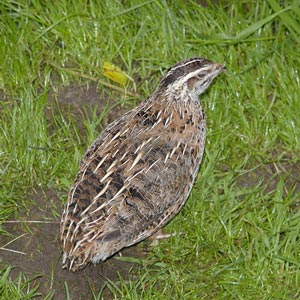Pratique | Débuter
Les oiseaux vénéneux, des pitohuis aux cailles

La Caille des blés (Coturnix coturnix) peut causer le coturnisme, une forme d’empoisonnement.Photographie : Mnolf / Wikimedia Commons
Introduction
En 1992, en Nouvelle-Guinée, l’ornithologue John Phillip Dumbacher a découvert par hasard qu’un passereau, le Pitohui bicolore (Pitohui dichrous), était vénéneux et qu’il produisait de l’homobatrachotoxine, un alcaloïde stéroïdien proche de celui que l’on trouve chez des grenouilles d’Amérique tropicale du genre Phyllobates. Cette toxine a également été trouvée chez d’autres pitohuis et chez l’Ifrita de Kowald (Ifrita kowaldi).
Des cas de toxicité ont aussi été signalés chez des oiseaux aussi différents que la Colombine élégante (Phaps elegans), l’Oie-armée de Gambie (Plectropterus gambensis), la Gélinotte huppée (Bonasa umbellus), la Paruline rouge (Ergaticus ruber) ou la Caille des blés (Coturnix coturnix).
Après une présentation de la défense chimique des pitohuis (découverte, origine, production et objectifs), nous vous proposons un aperçu des autres oiseaux pouvant être vénéneux.
Abstract
In 1992, in New Guinea, during an expedition to New Guinea, the ornithologist John Phillip Dumbacher accidentally discovered that the Hooded Pitohui (Pitohui dichrous) was poisonous and it produced the homobatrachotoxin, a steroidal alkaloid close to that found in tropical American frogs of the genus Phyllobates. This substance has also been found in other pitohuis and in the Blue-capped Ifrit (Ifrita kowaldi).
Chemical protective cases have also been reported in birds as diverse as the Brush Bronzewing (Phaps elegans), the Spur-winged Goose (Plectropterus gambensis), the Ruffed Grouse (Bonasa umbellus), the Red Warbler (Ergaticus ruber) and the Quail (Coturnix coturnix).
After a presentation of the toxicity of pitohuis (discovery, origin, production and aims), we present other species known as being dangerous.
Poursuivez la lecture de cet article, en vous abonnant dès maintenant !
Découvrez les Archives d’Ornithomedia.com
Pour seulement 10,00 €TTC/an (ou 6,00 € les 6 mois)
Profitez de plusieurs centaines d’articles en accès illimité et sans aucun engagement.
Compléments
À lire aussi sur Ornithomedia.com
- Voyage ornithologique en Nouvelle-Guinée du 3 au 23 décembre 2011
- Les paradisiers, des oiseaux passionnants
- Les rondes d’oiseaux
- Comment le Caracara à gorge rouge parvient-il à piller des nids de guêpes agressives ?
- Certains oiseaux nichent près des colonies de guêpes pour se protéger des intrus
- Ces oiseaux qui suivent les fourmis légionnaires pour se nourrir
Ouvrages recommandés
- Insect Repellents: Principles, Methods, and Uses de Mustapha Debboun et Stephen P. Frances
- Alkaloids: Chemical and Biological Perspectives de S.W. Pelletier
- Birds of New Guinea de Bruce M. Beehler (Auteur), Dale A. Zimmerman (Auteur), Thane K. Pratt (Auteur)
- Papua New Guinea Birds de Roy D. MacKay et Margaret MacKay
- Carte routière : Papua New Guinea (Carte) de Cartes ITM
- Lonely Planet Papua New Guinea & Solomon Islands de Regis St. Louis
Sources
- Mustapha Debboun et al (2014). Insect Repellents Handbook, Second Edition. CRC Press
- S. William Pelletier (2011). Alkaloids: Chemical and Biological Perspectives. Springer-Verlag New York
- Guillaume Lemoine (2009). Des grenouilles aphrodisiaques. Insectes (7) numéro 155. www7.inra.fr/opie-insectes/pdf/i155lemoine.pdf
- John P. Dumbacher, Gopinathan K. Menon, and John W. Daly (2009). Skin as a Toxin Storage Organ in the Endemic New Guinean Genus Pitohui. The Auk. Volume 126, numéro 3, pages 520-530. www.aoucospubs.org/doi/abs/10.1525/auk.2009.08230
- Sarah Legge et Robert Heinsohn (1996). Cooperative breeding in Hooded Pitohuis Pitohui dichrous. Emu. Volume 96.. www.publish.csiro.au/?act=view_file&file_id=MU9960139.pdf
- John Tidwell (2000). The Intoxicating Birds of New Guinea. Tidwell. webzoom.freewebs.com/midnightsea/intoxicatingbirdspng.pdf
- David E. Peacock, Per E. Christensen et Brian D. Williams (2011). Historical accounts of toxicity to introduced carnivores consuming bronzewing pigeons (Phaps chalcoptera and
P. elegans) and other vertebrate fauna in south-west Western Australia. Australian Zooologist. Volume 35. Numéro 3.. http://publications.rzsnsw.org.au/doi/pdf/10.7882/AZ.2011.034 - John P. Dumbacher, Kristy Deiner, Lindsey Thompson et Robert C. Fleischer (2008). Phylogeny of the avian genus Pitohui and the evolution of toxicity in birds. Molecular Phylogenetics and Evolution. Volume 49, numéro 3. Pages : 774–781. www.sciencedirect.com/science/article/pii/S1055790308004703
- Ben Otto Poulsen (1994). Poison in Pitohui Birds: Agains Predatrs or Ectoparasites. Emu. Volume 94. Pages 128-129.. www.publish.csiro.au/?act=view_file&file_id=MU9940128.pdf
- Bruce W. Kennedy et Louis Evan Grivetti (2010). Toxic quail: A cultural‐ecological investigation of coturnism. Ecology of Food and Nutrition. Volume 9, numéro 1. www.tandfonline.com/doi/abs/10.1080/03670244.1980.9990580
- Paul J. Weldon (2000). Avian chemical defense: Toxic birds not of a feather. PNAS. Volume 97. Numéro 24. Pages : 12948–12949. www.ncbi.nlm.nih.gov/pmc/articles/PMC34071/
- David C. Lewis, Elizabeth Metallinos-Katzaras et Louis E. Grivetti (1987). Coturnism: Human Poisoning By European Migratory Quail. Journal of Cultural Geography. Volume 7. Numéro 2. www.tandfonline.com/doi/abs/10.1080/08873638709478507#preview
- Darren Naish (2010). Death by toxic goose. Amazing waterfowl facts part II. ScienceBlogs. scienceblogs.com/tetrapodzoology/2010/06/19/death-by-toxic-goose/
- John P. Dumbacher, Avit Wako Scott R. Derrickson, Allan Samuelson, Thomas F. Spande et John W. Daly (2004). Melyrid beetles (Choresine): A putative source for the batrachotoxin alkaloids found in poison-dart frogs and toxic passerine birds. PNAS. Volume 101. Numéro 45. Pages : 15857–15860. www.ncbi.nlm.nih.gov/pmc/articles/PMC528779/




Aucun commentaire sur ce sujet
Participer à la discussion !